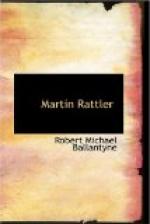Here the warriors were received with the utmost joy by the wives and children whom they had left behind, and for a long time Martin was left almost entirely to do as he pleased. A few days before, his bonds had been removed, and once or twice he thought of attempting to escape; but whenever he wandered a little further than usual into the woods, he found that he was watched and followed by a tall and powerful savage, whose duty it evidently was to see that the prisoner did not escape. The fearful idea now entered Martin’s mind that he was reserved for torture, and perhaps a lingering death; for he had read that many savage nations treated their prisoners in this cruel manner, for the gratification of the women who had lost relations in the war. But as no violence was offered to him in the meantime, and he had as much farina and fruit to eat as he could use, his mind gradually became relieved, and he endeavoured as much as possible to dismiss the terrible thought altogether.
The Indian village occupied a lovely situation at the base of a gentle hill or rising ground, the summit of which was clothed with luxuriant trees and shrubs. The huts were of various shapes and sizes, and very simple in construction. They were built upon the bare ground; some were supported by four corner posts, twelve or fifteen feet high, and from thirty to forty feet long, the walls being made of thin laths connected with wicker-work and plastered with clay. The doors were made of palm-leaves, and the roofs were covered with the same material, or with maize straw. Other huts were made almost entirely of palm-leaves and tent-shaped in form; and, while a few were enclosed by walls, the most of the square ones had one or more sides entirely open. In the large huts several families dwelt together, and each family had a hearth and a portion of the floor allotted to it. The smoke from their fires was allowed to find its way out by the doors and chinks in the roofs, as no chimneys were constructed for its egress.
The furniture of each hut was very simple. It consisted of a few earthen pots; baskets made of palm-leaves, which were filled with Spanish potatoes, maize, mandioca roots, and various kinds of wild fruits; one or two drinking vessels; the hollow trunk of a tree, used for pounding maize in; and several dishes which contained the colours used by the Indians in painting their naked bodies,—a custom which was very prevalent amongst them. Besides these things, there were bows, arrows, spears, and blow-pipes in abundance; and hammocks hung from various posts, elevated about a foot from the ground. These hammocks were made of cotton cords, and served the purpose of tables, chairs, and beds.




